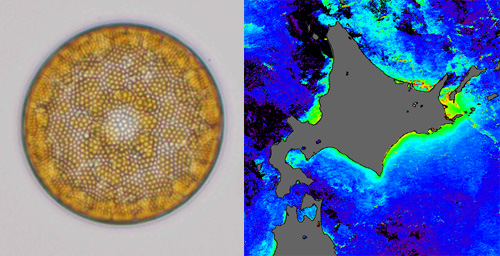ISADA, TomonoriAssociate Professor
Marine phytoplankton play a major role in aquatic carbon cycle. Oyashio regions, located in the northwest Pacific, is know to be the large seasonal biological drawdown of the CO2 partial pressure in surface water and one of the best fishing grounds in the world. Therefore, it is important to investigate and monitor the seasonal and annual changes in phytoplankton assemblages and primary productivity in this region.To understand the contribution of each phytoplankton functional group to marine biogeochemical cycles will be of great benefit for a wide range of assessment of environmental impacts on marine ecosystem.
Akkeshi Marine Station (AMS) is located in eastern Hokkaido, Japan. This region is known to be one of the richest nature in Japan. I hope that you have a good opportunity for studying biological oceanography and marine coastal ecosystem in AMS.
References
- Isada T., T. Hirawake, S. Nakada, T. Kobayashi, K. Sasaki, Y. Tanaka, S. Watanabe, K. Suzuki, and S.-I. Saitoh (2017), Influence of hydrography on the spatiotemporal variability of phytoplankton assemblages and primary productivity in Funka Bay and the Tsugaru Strait, Estuarine, Coastal and Shelf Science, 188, 199–211.
- Isada T., T. Hirawake, T. Kobayashi, Y. Nosaka, M. Natsuike, I. Imai, K. Suzuki, and S.-I. Saitoh (2015), Hyperspectral optical discrimination of phytoplankton community structure in Funka Bay and its implications for ocean color remote sensing of diatoms, Remote Sensing of Environment, 159, 134–151.
- Isada T., T. Iida, H. Liu, S.-I. Saitoh, J. Nishioka, T. Nakatsuka, and K. Suzuki (2013), Influence of Amur River discharge on phytoplankton photophysiology in the Sea of Okhotsk, Journal of Geophysical Research – Oceans, 118, 1995–2013.
Website
Akkeshi Marin Station FSC, Hokkaido University
Faculty
Field Science Center for Northern Biosphere
Grad School
Graduate School of Environmental Science
Division of Biosphere Science
Contact Information
Email: t-isada ![[atmark]](https://www2.sci.hokudai.ac.jp/dept/bio/wp/wp-content/themes/sci-bio_2407/img/atmark.png) fsc.hokudai.ac.jp
fsc.hokudai.ac.jp

